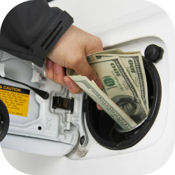 12. Remember what you learned in driver's education class: Don't tailgate, maintain consistent speed, drive the speed limit, and anticipate stop signs. Changing speeds constantly reduces efficiency. Decide what's more important to you: Arriving a couple of minutes (or usually just a few seconds) earlier, or saving money.
12. Remember what you learned in driver's education class: Don't tailgate, maintain consistent speed, drive the speed limit, and anticipate stop signs. Changing speeds constantly reduces efficiency. Decide what's more important to you: Arriving a couple of minutes (or usually just a few seconds) earlier, or saving money. 13. Got junk in your trunk? Empty it. Any extra weight reduces fuel efficiency. Also, take off any bike or ski racks if you're not using them. They can cause drag, making your car work harder to maintain speed. 14. Take care of your car. Regular oil changes improve gas mileage. Be sure to regularly change air filters, keep your tires properly inflated, and use a fuel injector cleaner, too. 15. When you are ready to fill up, fill it up all the way! Gas is expensive today, and chances are it'll be even more costly tomorrow. If you fill the tank completely, you can go longer between fill-ups. 16. Know your route. Getting lost is a waste of time and money. Sometimes it can't be avoided, but plan your routes in advance or use a global positioning unit. Carry a map, and use it! 17. Be shady. Park in the shade. Gas can evaporate on a hot day, especially when you park in the sun. Also, parking in the shade keeps the inside cooler, meaning you have to use the air conditioning less. 18. Speaking of AC. Only use it on the highways. It's more efficient to roll down the windows when you're going 40 miles per hour or less. The air conditioning is a better choice when you're going faster. 19. Slow down. Obeying the speed limit is more efficient for your car-especially on the highway. Gas mileage decreases rapidly at speeds above 60 mph. Each 5 mph you drive over 60 mph is like paying an additional $0.30 per gallon for gas. Besides saving gas, driving the speed limit is also safer for you and your passengers. 20. Don't stop. Didn't we just mention safety? Yes. Always obey traffic laws and be watchful of the vehicles and pedestrians around you. However, if you can safely (and legally) slow down enough to avoid actually stopping (such as when a stop light is a long way ahead of you), then do it. It takes less gas to speed up than to start from a full stop. Follow these tips, and soon you'll be saving some pennies (and eventually some nickels, dimes or even dollars)! If you think those of us in North America have it bad, think of our brethren in Europe: Gas tops $8 a gallon on much of the continent, including Norway, Britain, Belgium and Germany. Ouch! For more information on saving gas and picking a fuel-efficient vehicle, check out www.FuelEconomy.gov, a website maintained by the U.S. Department of Energy's Office of Energy Efficiency and Renewable Energy (DOE) and the U.S. Environmental Protection Agency (EPA). |
20 Tips to Save Money on Gas
Small Changes Can Improve Efficiency by 30%
‹ Previous Page Page 5 of 5






Member Comments